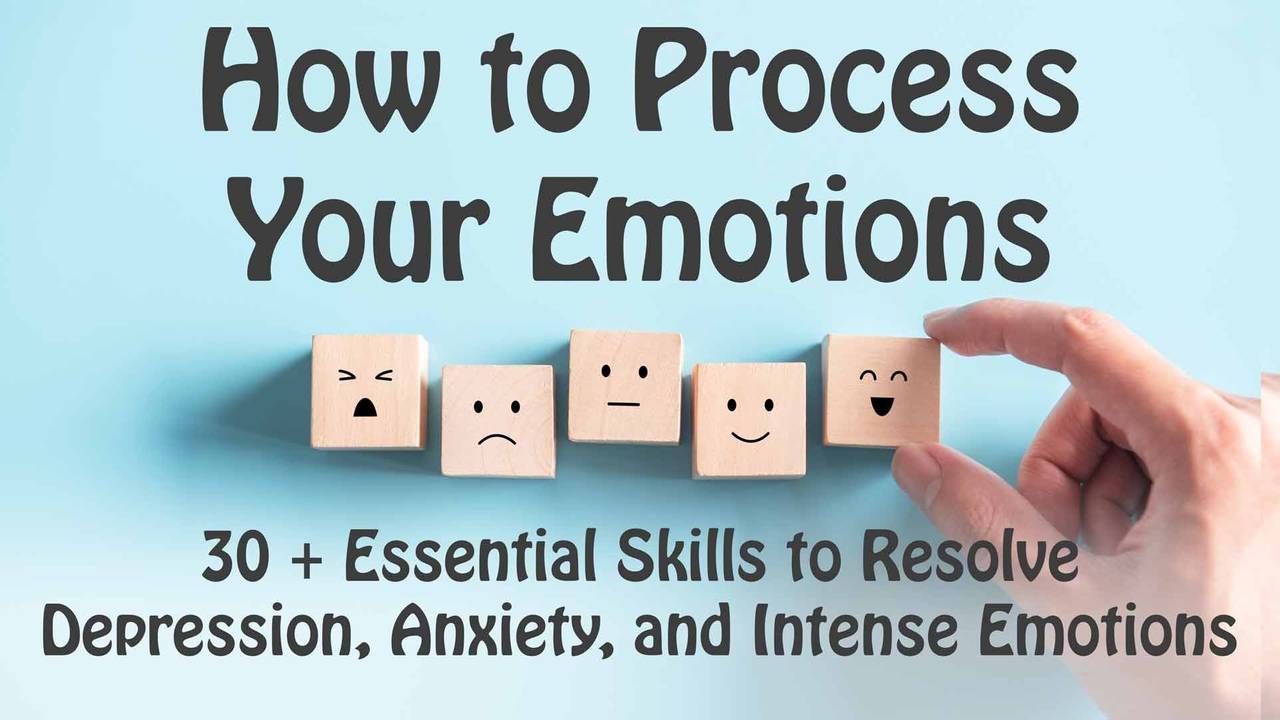You can’t always believe everything you feel. Sometimes strong emotions are actually covering up deeper emotions. In the 7th skill in my How to Process your Emotions course you’re going to learn about Primary and Secondary Emotions.
Secondary Emotions can Deceive You
A wise Jedi once said, “Fear leads to anger, anger leads to hate, hate leads to suffering.” – Yoda
You can get better at feeling by learning where your feelings are coming from.
Are you ready to start resolving, letting go of some of those distorted and painful feelings? I hope the last couple of sections have helped you get the idea that the process of struggling with, and shaming your emotions, makes you feel worse, but I also hope that you haven’t gotten the idea that you just have to feel crappy forever. You just have to go through the stage of feeling in order to get to the stage of feeling better.
Just because we aren’t labeling emotions as “good” or “bad”, and we aren’t struggling with or fighting them, doesn’t mean that all emotions are truthful, or helpful, or even what we’re really feeling. There’s a lot of reasons why something we’re feeling isn’t going to be helpful, but to get to the point where we’re exploring that, we have to stop judging, resisting, and labeling our emotions long enough to explore them and figure out what’s under them.
So there’s a lot of reasons why what we’re feeling isn’t based on reality, it could be cognitive distortions, an unhelpful worldview, self-justification, or what we’re going to talk about in this section – secondary emotions.
What are Secondary Emotions?
Secondary emotions are a habitual or learned response to cover up sensitive emotions with a less sensitive emotion. For example, fear is sensitive and hate is less sensitive. Secondary emotions are all about self-protection, but in the long run, they tend to hurt us much more by ruining relationships, keeping our guard up, or keeping our heart walled off and that often leads people to feeling angry, numb, exhausted, and lonely. Secondary emotions lead to more pain and suffering, so in this section you’re going to learn what they are, how to notice them, and what to do instead, and this going to help you more effectively overcome anxiety, depression, and get better at feeling.
Primary vs. Secondary Emotions
One of the reasons we have a difficult time knowing how to act on our emotions is that many of the emotions we feel are “secondary emotions”. They are an emotion about an emotion, instead of an emotion about an event, and usually they’re used to cover up your primary emotion.
For example: “I get a bad grade on a test, so I am disappointed.” (There’s the primary emotion.) “That disappointment hurts because I know I didn’t study hard enough, so then I get angry. I storm out of the class and then I feel ashamed because I got angry, because I know it was my fault I didn’t do well.” (The anger and the shame stem from the reaction to the disappointment.)
Or: “I just found out that we have to move to a different city because my Dad got a new job, and I’m sad.” (Primary.) Then, “I feel guilty for feeling sad because I know I should be supporting my family and my Dad even though I don’t want to move.” (Secondary; guilt comes as a learned response to the sadness.)
Or “I hate my boss.” You may think that saying something like that outloud is a healthy emotional expression, and it may help you get started, but if you just stick with “I hate her”, it doesn’t leave you with very many options. You can quit, you can gossip, you can be bitter and complain and dread going to work. If you stop to think; why do you hate your boss? Is it because she is critical? Is it because she gives you too much work, or doesn’t appreciate the hard work that you do? If you “hate her” because she’s critical, what is that really about? Fear? Being afraid that you’re not good enough? Being afraid that you’ll get fired and run out of food and die? What you thought was hate was really the stress response. When you realize the emotion is really about fear, then it gives you some options. If you feel afraid, ask yourself “Am I actually in danger? Am I actually not good enough? Do I need to develop some new skills?” or “Do I need to set better boundaries, be more assertive and acknowledge my own wins and strengths and resources more?” When we get beneath the surface emotions, we often open up a huge set of options, ways we can change our life and resolve our painful emotions. When we just stick with secondary emotions, we’re more likely to experience anxiety, and depression, and not even know where it’s coming from.
Anger is Often a Secondary Emotion
Anger is one of the most common secondary emotions. Because people, especially boys, have been taught that it’s not ok to cry, be sad, or be vulnerable, anger is the most convenient emotion to cover up those feelings. What looks like anger on the surface is often a protective cover for feelings like: hurt, fear, embarrassment, worry, or sadness.
Shame is one of the other most common secondary emotions, especially among women. If you’re not allowed to be angry at others, it’s easy to cover up that anger by blaming yourself for your flaws.
It’s easy to see how both of these emotions are harmful in our lives and relationships, but with a little consideration it’s easy to see how they are easier to feel than the underlying real emotion (at least in the short term). It was way more comfortable to be angry at a “dumb test” than it is to feel guilty about not studying; guilt asks that you work harder at studying.
Let's Compare Primary vs. Secondary Emotions
Let’s explore the difference between primary and secondary emotions:
Primary Emotions | Secondary Emotions |
Instinctive, natural, can be inherently good/functional but when reacted to they can also be harmful. | Learned, protective, defensive, avoidant. More controlled |
They “Feel”, they can be painful or pleasurable. Sensitive, and vulnerable. | They attempt to control/numb emotions w/o listening to what the emotions are- asking-teaching-helping. |
These are rooted in the deeper parts of our brain (see Skill# 9) and animals also have many of these emotions, leading to the idea that they are evolutionary and provide a survival benefit. | They tend to come from learning. ie “I shouldn’t cry now” or “I shouldn’t be mad”. This is not the same thing as intentional self- control, this is a mindless reaction. A pushing away that is motivated by pain reduction |
These are also the emotions that keep us connected with others and can guide our actions. | Secondary emotions require a certain amount of numbing, they generally lead to distance and disconnect from our goals, values, and people. |
Secondary Emotions Can Get in the Way
Secondary Emotions make it hard to really solve problems and feel better.
Don’t get me wrong, I’m not saying that we should just blindly act on all our deep impulses, I do believe that we have some emotions that are quite natural and also quite harmful. I’m saying we should be intentional.
- Know what we are feeling.
- Explore why we are feeling it.
- Choose what we want to do about it.
If we just act on our secondary emotions we might not be able to solve any problems, we’ll just spin our wheels. Secondary emotions are not a form of self-control, they are just another way to be reactive. This is because secondary emotions don’t take the time to notice or explore the emotion, they just want it to go away at any cost. They keep us from knowing what we are feeling.
When we act out on secondary emotions we tend to attack, criticize, demand, or blame. This leads to constant problems like bad relationships, loneliness, more stress, and addiction. Acting on secondary emotions pushes others away and makes it seem impossible to solve problems.

Vulnerability Is Actually a Superpower
When we choose to be willing to feel our sensitive emotions, we’re more likely to build connections with others and solve our problems, really kickstarting the positive cycle of feeling more calm, happy, peaceful and loved. That’s why vulnerability is a superpower. People who can learn to be vulnerable, to feel those tender emotions, they have better jobs, better relationships, and they’re just happier.
The next time you are feeling wrapped up in an intense emotion, take a deep breath, pause, and then explore: “Is there something underneath this emotion? Is there something more sensitive down there?” Mindfully make room for that feeling, and explore what it has to teach you.
Here are some examples:
- Jealousy – blames others for doing well, protecting you from the responsibility of trying hard, but leaves you feeling bitter.
- Resentment – protects you from connection and the risk of being hurt, but leaves you lonely.
- Blame – protects you from responsibility and guilt, but leaves you helpless.
- Hopelessness – protects you from having to keep trying, but leaves you depressed.
When we react to our emotions or avoid them, when our only tool is to say “I feel bad, and I don’t like it”, we don’t give ourselves many options to solve problems or resolve emotions. We are more likely to find resolution to our problems and our emotions, when we look deeper than the surface. This is where your skills of noticing and naming emotions, not judging them or avoiding them, and being willing to feel them really start to come into play. You’ve moved from the foundational level to the action level.
Steps to Recognize Primary Emotions
- Being curious about your emotions opens up the possibility of change.
- Start by asking “What am I feeling?”
- Allow yourself to wonder “Where is this emotion coming from?”
- Then ask “How did I come to feel this way?”
- And finally, “Is there something more sensitive underneath?”
This can be really hard to do in the moment of intense emotion, so it’s a good idea to practice this after the fact in writing. Check out the workbook activities to get better at identifying and acting on primary instead of secondary emotions.
You can’t always believe everything you feel. Sometimes strong emotions are actually covering up what you’re really feeling. You can gain much better emotional control if you learn to identify the feelings under your feelings.
The next time you are feeling wrapped up in an intense emotion, take a deep breath, pause, and then explore: “Is there something underneath this emotion?” Is there something more sensitive down there?” Mindfully make room for that feeling and explore what it has to teach you. In the next couple of sections I’m going to teach you some skills to slow yourself down, and calm yourself down, so that you can process through your emotions.
This is part of a 30-section course, How to Process Emotions. Check out the full course with added bonuses below.





